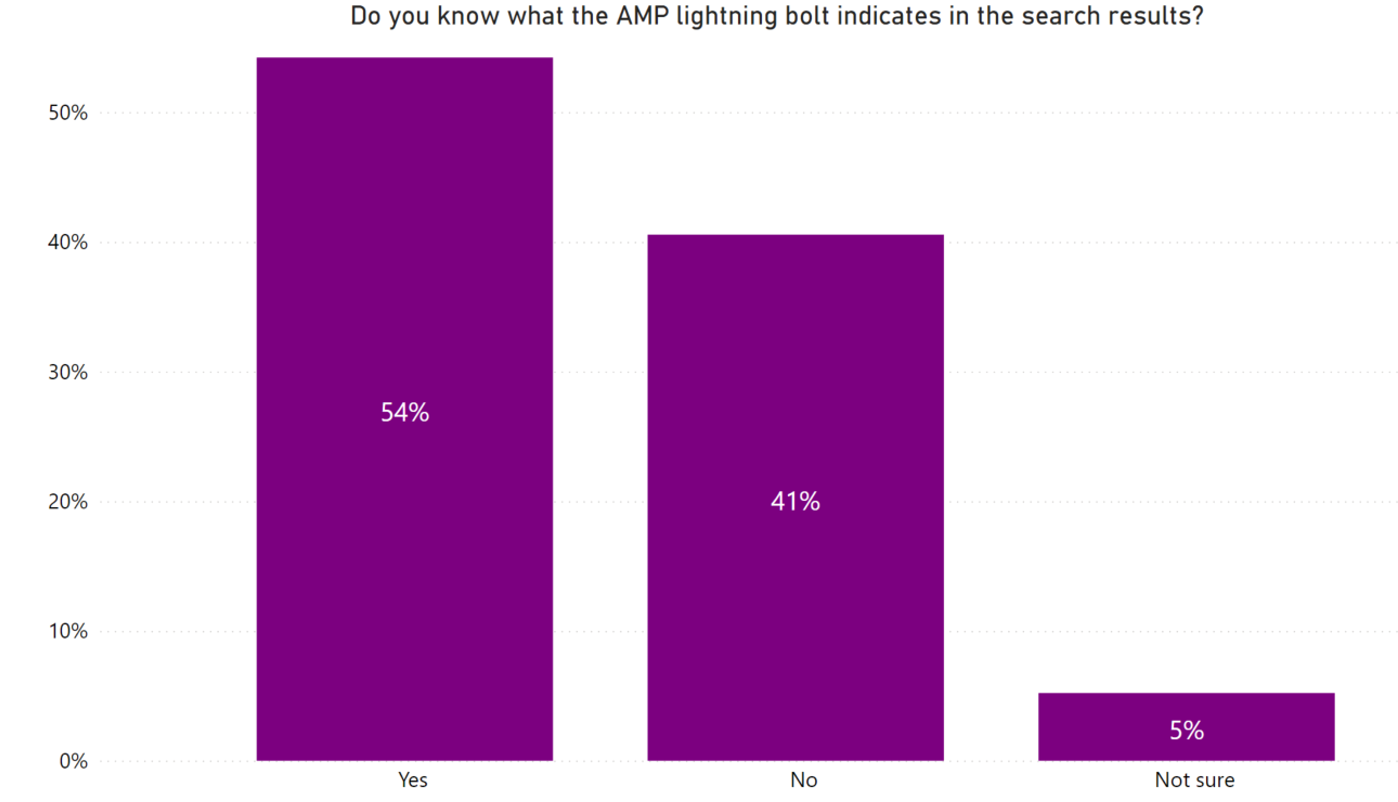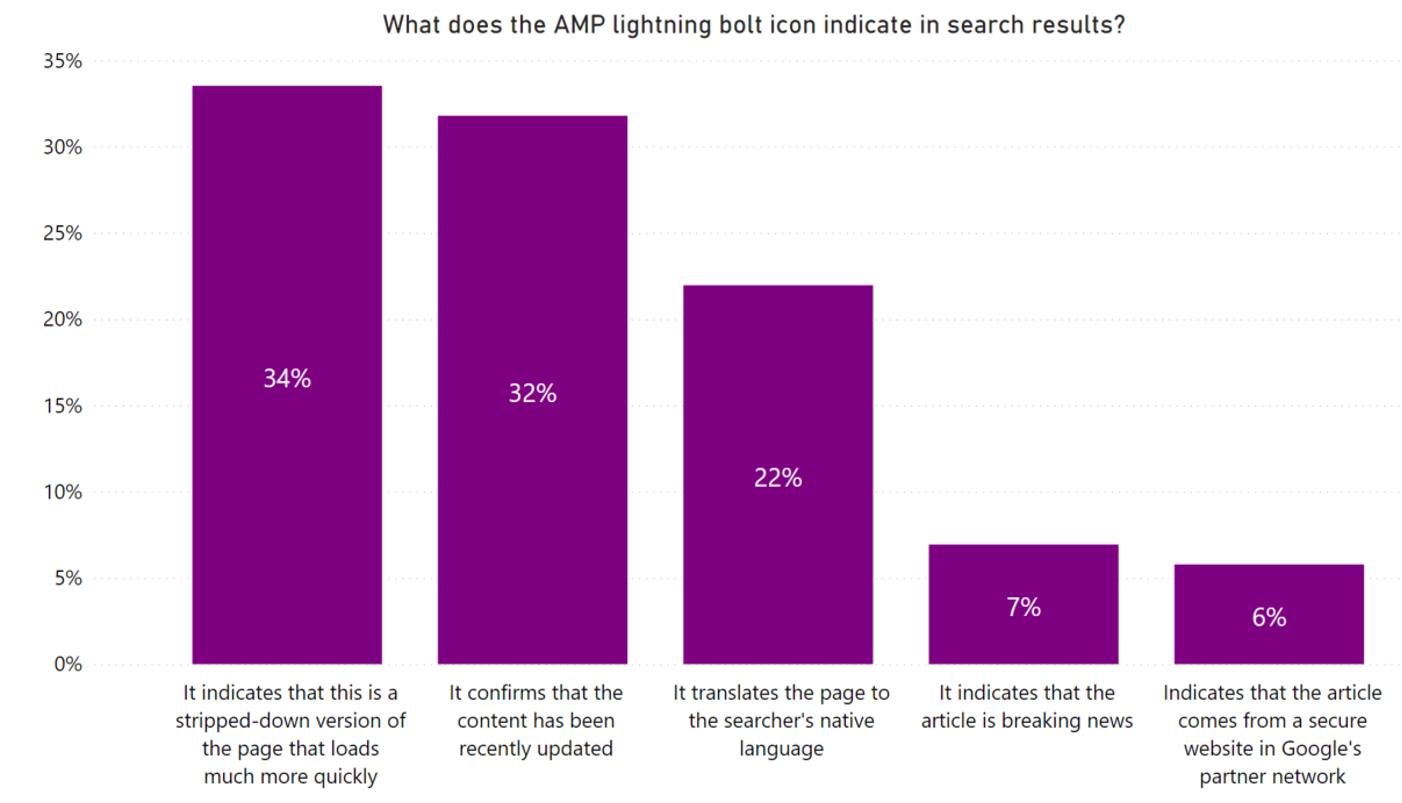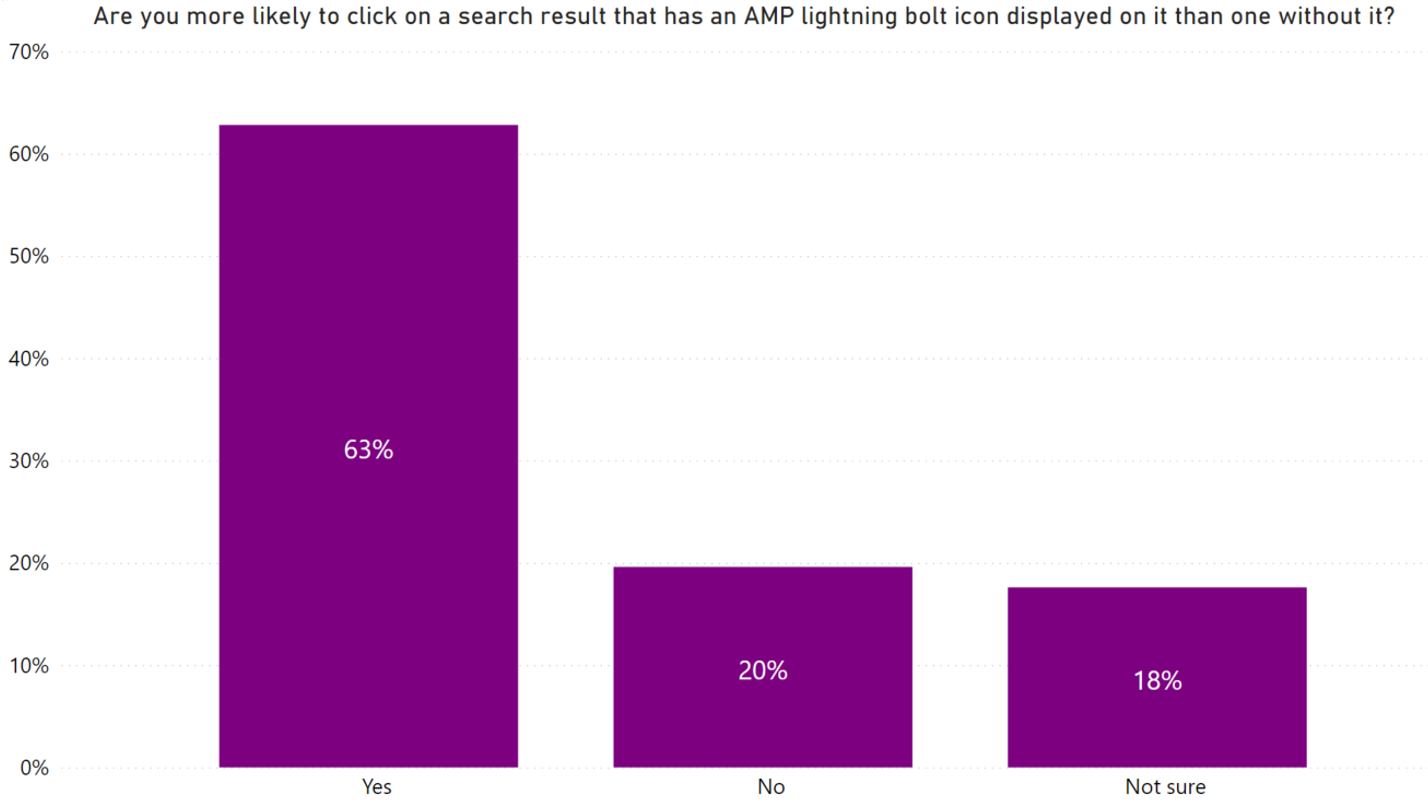The upcoming Google Page Experience Update has been one of the most popular topics in the SEO community in the past year, due to its emphasis on optimizing Google’s Core Web Vitals metrics.
But there are some other aspects of the update that haven’t received as much visibility, such as what Google plans to do with AMP: Accelerated Mobile Pages.
In this column, you’ll learn more about upcoming changes to AMP, particularly around Google’s deprecation of the AMP icon.
Does the AMP icon increase CTR and what does the average searcher think of the badge when they see it in the SERPs, anyway?
I’ll share results from a recent survey on what users really think of the AMP icon, with commentary on what it could mean when it’s taken away.
Let’s start with a bit of helpful background for context.
Google is Removing the AMP Requirement for Top Stories
In May of 2020, Google announced that as part of the Page Experience Update (now launching in mid-June), AMP will no longer be a requirement for sites to rank in the Top Stories carousel on mobile devices.
This will expand the eligibility of sites not using AMP to be able to appear in that SERP feature.
The Top Stories carousel is one of the most coveted spots in the search results for publisher sites to rank, given the enormous amount of organic traffic that flows through there.
This aspect of the Page Experience Update is welcome news for many publishers who have been skeptical of adopting AMP as well as those who have avoided using it due to negative impacts on advertising revenue and/or the amount of work required to maintain compliant AMP URLs.
In theory, removing the AMP requirement for Top Stories on mobile could also result in many more sites ranking in Top Stories, given that there will no longer be a technical barrier to entry.
However, the remaining requirements for ranking in Top Stories are strict.
According to Google News expert John Shehata, these are some of the ranking factors that help sites to appear in Top Stories:
- Overall authoritativeness of the publication.
- A clear focus on entities in the headlines and content.
- Topical authority of the publication (i.e., sports, local news).
- Trustworthiness (credible authors, factual integrity).
- Citations and buzz (links and social media shares).
- Article click-through rate.
Google patent expert Bill Slawski also wrote a thorough article last year about a patent Google was granted in March of 2019 called Automated News Digest.
In this patent, Google explains how it assigns “Importance Scores” to pages, which then determines how those pages are ranked in Top Stories.
The factors that contribute to a news story’s Importance Score largely resemble the above recommendations made by Shehata, such as recency, social shares, and the authority of the publication and the author.
For sites hoping to capitalize on the expanded eligibility of Top Stories rankings, the above recommendations will continue to be important.
However, AMP no longer serving as a technical requirement for ranking in Top Stories on mobile devices doesn’t imply that page performance won’t be an important ranking factor for this SERP feature.
It’s likely that Core Web Vitals will play an important role in the rankings of Top Stories content, perhaps even more so than in the rest of the search results.
This is especially true if some publishers continue using AMP, which offers Core Web Vitals performance metrics that can be difficult to compete with for non-AMP URLs.
Google Deprecating the AMP Icon
When Google recently announced that the Page Experience update would be postponed to mid-June, they also snuck in a new detail related to AMP:
“Additionally, we will no longer show the AMP badge icon to indicate AMP content. You can expect this change to come to our products as the page experience update begins to roll out in mid-June. We’ll continue to test other ways to help identify content with a great page experience, and we’ll keep you updated when there is more to share.”
I thought this portion of the announcement was interesting, although most of the other news-focused SEO professionals I spoke to said something along the lines of, “It won’t matter; no one pays attention to the AMP badge.”
This is a question I’ve been wondering about for years. Do users care about the AMP badge?
As digital marketers, we know what the badge symbolizes and therefore may be more prone to click on it as a result.
However, as with many ways that SEO pros navigate the SERPs, this behavior is not necessarily reflective of the average user.
Does the AMP Badge Increase Click-Through Rate (CTR)?
The most significant study done to date to answer the question of whether using AMP improves a page’s CTR is this 2019 study done by Perficient Digital. Here are the results of the study:
Overall, 22 of the 26 websites (77%) experienced organic search gains on mobile. Other areas of improvement include SERP impressions and SERP click-through rates. A summary of the results across all 26 sites is as follows:
- 27.1% increase in organic traffic.
- 33.8% increase in SERP impressions.
- 15.3% higher SERP click-through rates.
According to this study, AMP definitely increases click-through rates. Despite many SEO professionals believing that the appearance of an AMP badge alongside an article has no impact on CTR because most users don’t know what the badge does, the results of this study didn’t surprise me.
Similar to other rich result features such as star ratings, timestamps, image thumbnails, and sitelinks, the presence of a special ‘badge’ alongside an organic result could be enough to increase CTRs, even if users don’t fully understand what it means.
An Updated Analysis: AMP’s Impact on CTR Using Client Data
My SEO team at Amsive Digital works with a number of publisher clients, and one of them recently experimented with turning AMP on and off for a 2-week period.
I was able to use this data to analyze the performance of the same articles with and without AMP enabled.
I controlled for position by collecting CTR data only when the article was ranking in the same position with AMP turned on or off.
I also filtered by results using the AMP Non-Rich Result filter in Google Search Console.
(These results show up in the 10 blue links, with the only difference being that the lightning bold badge is displayed.)
I compared the two weeks during which the articles were AMP-enabled to the two prior weeks when AMP was not being used. I also filtered the results to mobile devices only.
 Client URLs are redacted
Client URLs are redactedAmong the 186 articles analyzed, the CTR improved by 11.9%, on average, with AMP enabled.
Although it is believed that AMP has no impact on CTRs because most users don’t know what the AMP badge means, both the Perficient study and my mini-analysis proved that the presence of the AMP badge can improve CTR by at least 11%.
Next, I wanted to dig into whether it’s true that most users don’t know what the AMP badge is or does.
What Does the Average User Think About the AMP Badge in Search Results?
To get a deeper understanding of whether the average user even knows what the AMP ‘lightning bolt’ icon symbolizes, I conducted a small survey using Mturk, to avoid the results being skewed among digital marketing professionals. There were 250 respondants.
Disclaimers: This survey uses a small sample size and, of course, users’ responses about how they use Google do not always align with how they will actually behave when clicking on the search results.
However, given that we don’t get access to this data directly from Google, I thought it would be interesting to see what the average user believes about the role of the AMP icon in search results.
AMP Survey Results:
1. Do You Know What the AMP Lightning Bolt Indicates in the Search Results?
This question was presented with four visual examples of articles displaying the AMP lightning bolt badge, with the badge circled.
 Fifty-four percent of respondents indicated that they knew what the AMP badge means in search results.
Fifty-four percent of respondents indicated that they knew what the AMP badge means in search results.
2. For Those Who Answered “Yes” to the Above Question, What Does the AMP Lightning Bolt Icon Indicate in the Search Results?
This question put the users’ knowledge to the test – among those who believed they knew what the AMP icon does, only 34% answered correctly that AMP serves a stripped-down version of a page that loads more quickly (the far-left column).
Interestingly, a significant percentage (32%) of respondents thought the lightning bolt indicated that the content was recently updated, and 22% thought AMP translates the page content.
In other words, a much higher percentage of respondents got this answer wrong than they did right.

3. Are You More Likely to Click on a Search Result That Has an AMP Lightning Bolt Icon Displayed on It Than One Without It?
This question had no images or visual cues about what the AMP lightning bolt looks like in the search results.

Interestingly, a strong majority of respondents indicated that the presence of an AMP lightning bolt would increase the likelihood of them clicking on that result.
But again, this question was not presented with any visual cues and survey responses are not the same as actual search behavior.
It’s possible users aren’t fully aware of how they interact with search results.
To add to that, as shown in the question above, most respondents don’t even appear to entirely understand the purpose of the AMP badge.
4. Does the Grey AMP Lightning Bolt Icon Displayed Below (3rd Result) Have Any Impact on Your Desire to Click on Any of the Search Results?
For the next question, respondents were given a visual example of an AMP result compared to two non-AMP results in the SERP to see whether their response would be any different.
See the screenshot below for reference.

![]()
Perhaps unsurprisingly, respondents answered differently than their previous answers when they were presented with a real-life example of AMP in the search results.
There was no clear winner in terms of whether the AMP badge made users want to click on that result more, perhaps because they realized that there are other factors that contribute to the click-through rate, such as the images, headlines, descriptions, and timestamps also displayed.
Respondents may also have preferences towards certain publications that could also impact CTR.
5. If You Are More Likely to Click on Results With the AMP Icon, Why Do You Prefer Clicking on These Results? Select All That Apply.
This was a more straightforward question in which the user could select multiple options about why the AMP icon is appealing to them.
Of course, not all of these answers are not entirely correct or applicable to all AMP pages, but it was interesting to see how users responded.
The majority indicated that they prefer AMP because of the better UX of AMP pages and their fast load times, which is consistent with the overall mission of the AMP project.
Will It Matter That Google Is Taking the AMP Badge Away?
While survey data is not entirely reliable, there are some indications in the above responses that users did appreciate the presence of an AMP badge to indicate that pages would load more quickly and otherwise present a better experience.
Furthermore, the study by Perficient, as well as my analysis of recent client data, both indicate that the AMP badge can increase CTR by anywhere from 11.9% – 15.3%.
This could cause some upcoming fluctuations in CTR and traffic for sites that have historically benefitted from that increased CTR stemming from the AMP badge.
Google has indicated that it may experiment with other badges and labels to indicate when a page will have a good experience,
Perhaps we won’t miss the AMP badge too much when it ends up in the long list of things Google has deprecated over the years.
More Resources:
- 7 Tips to Improve Your Core Web Vitals Scores & Page Experience Signals
- History of Google Algorithm Updates
- Core Web Vitals: A Complete Guide
Image Credits
In-post images 2-4, 6-7: Amsive Digital
All screenshots taken by author, May 2021

![Google Ditches AMP Badge In Search; Will It Matter? [Survey Results]](https://www.searchenginejournal.com/wp-content/uploads/2021/05/google-will-no-longer-display-the-amp-icon-60a4ebb8c5ae4.png)



